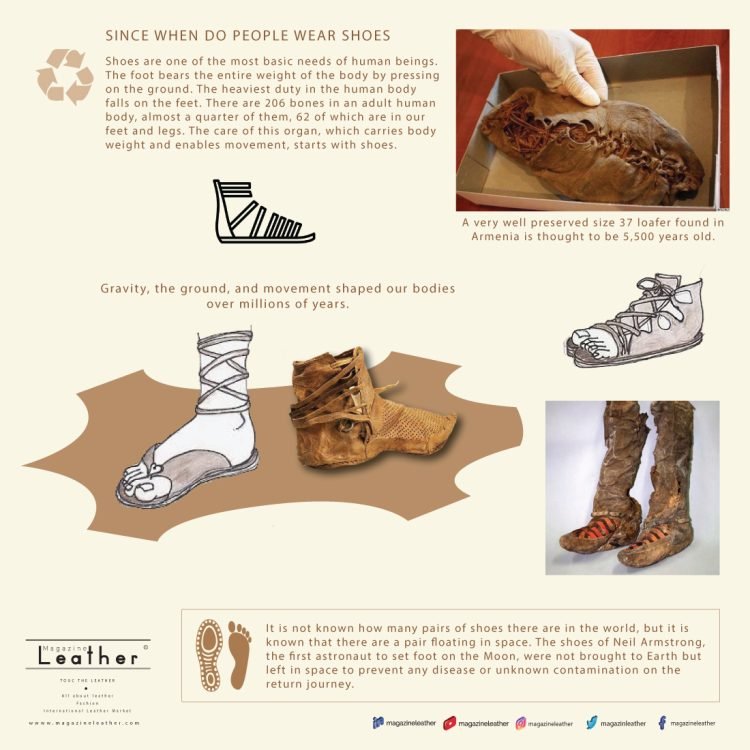Shoes are one of the most basic needs of human beings. The foot bears the entire weight of the body by pressing on the ground. The heaviest duty in the human body falls on the feet. There are 206 bones in an adult human body, almost a quarter of them, 62 of which are in our feet and legs. The care of this organ, which carries body weight and enables movement, starts with shoes.
The foot bones do not rest flat on the ground. It is pressed on both ends and edges of a concave dome called the base pit. The structure of the sole of the foot is quite complex. There are many muscles, tendons, vessels and nerves here. The strongest of the muscles in our body are found in our soles. Protecting this area, which is one of the most sensitive parts of the human being, is very important for human life. Most shoes consist of a thick lower part, called the ‘sole’, which wears out with use, and a thinner upper part, called the ‘upper’, which hugs the foot. Just as shoes vary according to the living conditions of people living in very different climates around the world, fashion has also had a great impact on the shapes of shoes throughout history. Although cave paintings in Spain dating back to 12-15 thousand years ago show clothing made of leather for men and fur for women, the oldest shoe print in the world was found in Mesopotamia, which hardened in the drying mud and has survived to this day.
It is thought that shoes, with their current meaning and form, first appeared in countries with hot climates, in the form of sandals. The first shoes were made by turning raw leather into an envelope that the foot could fit into. These shoes protected the bottom of the foot from hot sand and the top of the foot from the sun and heat. In Egyptian works of art, rulers and gods are always seen barefoot. It is estimated that sandals were only worn indoors during this period. The Hittites wore shoes similar to the sandals that are still used in Anatolia today, although only rarely.
In the Middle Ages, a father whose daughter was getting married would transfer his authority over her to the man he would marry with a shoe ceremony. Today, in some Western countries, the custom of tying the newlywed couple’s shoes to the back of their car is a legacy of those days, when the girl’s father gave one of his daughter’s shoes to his son-in-law, indicating that he is now under his protection.
Pointed-toe shoes became fashionable in Europe from the 11th to the 15th centuries. In the Middle East region, heels were added to shoes to keep the feet elevated to protect them from hot sand. In the 16th and 17th centuries in Europe, the heels of all shoes were painted red.
Until the 18th century in Europe, women’s and men’s shoes were not different. In those years, only upper-class people in Europe could wear high-heeled shoes with a height of up to 15 centimeters (with the help of two people, of course).
Did you know that until the 19th century, identical shoes were used for both feet all over the world, that is, there was no difference between right and left in shoes? The production of separate shoes for right and left feet was first started in Philadelphia, USA. Rubber sole shoes were first made in the USA in 1916 and were called ‘ket’ (ked). Boots, on the other hand, emerged in cold and mountainous regions and hot and sandy deserts where horseback riding was common. The first boots for women were designed for Queen Victoria in 1840. Comfortable lace-up walking shoes appeared during the First World War.
Shoemaking was very developed in the Ottoman Empire due to the highly developed art of leather processing and the need of the Janissary Corps for soft leather boots suitable for horse riding. Today, even in the most primitive communities, people wear some kind of shoes.
It is not known how many pairs of shoes there are in the world, but it is known that there are a pair floating in space. The shoes of Neil Armstrong, the first astronaut to set foot on the Moon, were not brought to Earth but left in space to prevent any disease or unknown contamination on the return journey. Now they’re wandering around in space. I wonder where the shoes of the other astronaut and those who went later are now?









